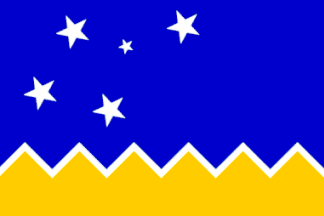
Last modified: 2006-09-30 by antónio martins
Keywords: xii | southern cross (slanted) | stars: 5 | star: 5 points (white) | magallanes y antártica chilena | magellan | claim | antarctica | magalhães | coat of arms: tierced per pile | prima in terra chilensis |
Links: FOTW homepage |
search |
disclaimer and copyright |
write us |
mirrors

I saw recently the flag of the Region XII of Chile, i.e.
Magallanes y Antártida Chilena, in Punta Arenas, the capital of this
region, flying along the chilean national flag, in front of the seat of
the regional government (Nogueira with José Menéndez corner).
Pere Mir, 18 Dec 2000
It is rectangular, having the height two thirds of its length, and
is divided in two fields. The upper one is blue where the constellation
grazes in the fields of the South Cross, and the lower with the edge
serrated symbolizing a mountainous horizon, in ochre yellow. The fields
are separated by a narrow white stripe. The ochre yellow is the colour
of the typical vegetation of the steppe, the physiographic form most
characteristic of the regional, expressive geography as well of the
wealth of its ground and its subsoil. The parallel white band to the
serrated edge symbolizes the snow that crowns the mountains.
Sergio Arenas, quoting from
http://www.puntaarenas.cl/,
24 Aug 2001
Photo of this flag was
posted to me by the regional government when I asked for. Flags and
arms of the region are official after 5 february 1997 (publication
in the Diario Oficial de Chile). Aprobation for regional
council was in 12-9-1996.
Jaume Ollé, 28 Jan 2001
Adopted 15 October 1996 by regional resolution nr 42.
J.J.Andersson, 06 Jul 2002
With the flag and shield were adopted also a cockarde,
a logo, an animal, a flower, a plant and a tree. The info was
posted by the regional government.
Jaume Ollé, 19 Aug 1998
The Magallanes and Antartica flag is 2:3. The 1:2 version
seems that was originat when was confused with a proposal for
new australian flag.
Jaume Ollé, 24 Jun 2003
A nice flag. The Southern Cross is unusually positioned, at least
when you are used to see it in all
those flags positioned “vertically”. Is there any special
reason why this position was chosen?
Željko Heimer, 28 Jan 2001
Is this how it appears at that location at a specific time?
Terence Martin, 10 Sep 2003
It would appear at that angle at a different time every night of the year. Then again, in the Antarctic that limits it to 180 days. The height above the horizon would vary, though, so if you knew where the view was meant to be you could cut it down to two possible days equidistant from midwinter, and work out the time from that.
I suspect, though, that it is more for vexillological design than for a specific time — it is so close to the horizon that it cannot possibly be as it appears anywhere in the Antarctic (possibly as it appears in midwinter from Santiago?).
A third possibility is that it might be oriented that way because the Southern Cross constellation is so closely associated with Australia. An upright Southern Cross might cause confusion. Chile is about 110 degrees longitude from Australia and — coincidentally? — the Southern Cross on this flag is about 110 degrees from upright.
James Dignan, 10 Sep 2003
.gif)
It is Iberian style divided into three fields. In the right are
three chequered bands in red on a silver field, representing the arms
of the discoverer Hernando de Magallanes
[Fernão de Magalhães]. In the left side the Southern
Cross constellation hangs in the blue sky field reminiscent of the
mythology of the southern natives. The lower field is of ochre yellow,
signifying the importance of the steppe in the economic evolution and the
historical prosperity of the region. Under the shield and is the motto
«Prima in terra chilensis», indicative of the leading
geographic and historical of the region.
Francisco Abarzua, 24 Aug 2001
Anything below this line was not added by the editor of this page.